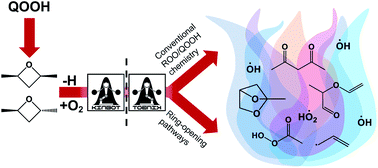Stereoisomer-dependent unimolecular kinetics of 2,4-dimethyloxetanyl peroxy radicals†
Abstract
2,4,dimethyloxetane is an important cyclic ether intermediate that is produced from hydroperoxyalkyl (QOOH) radicals in the low-temperature combustion of n-pentane. However, the reaction mechanisms and rates of consumption pathways remain unclear. In the present work, the pressure- and temperature-dependent kinetics of seven cyclic ether peroxy radicals, which stem from 2,4,dimethyloxetane via H-abstraction and O2 addition, were determined. The automated kinetic workflow code, KinBot, was used to model the complexity of the chemistry in a stereochemically resolved manner and solve the resulting master equations from 300–1000 K and from 0.01–100 atm. The main conclusions from the calculations include (i) diastereomeric cyclic ether peroxy radicals show significantly different reactivities, (ii) the stereochemistry of the peroxy radical determines which QOOH isomerization steps are possible, (iii) conventional QOOH decomposition pathways, such as cyclic ether formation and HO2 elimination, compete with ring-opening reactions, which primarily produce OH radicals, the outcome of which is sensitive to stereochemistry. Ring-opening reactions lead to unique products, such as unsaturated, acyclic peroxy radicals, that form direct connections with species present in other chemical kinetics mechanisms through "cross-over" reactions that may complicate the interpretation of experimental results from combustion of n-pentane and, by extension, other alkanes. For example, one cross-over reaction involving 1-hydroperoxy-4-pentanone-2-yl produces 2-(hydroperoxymethyl)-3-butanone-1-yl, which is an iso-pentane-derived ketohydroperoxide (KHP). At atmospheric pressure, the rate of chemical reactions of all seven peroxy radicals compete with that of collisional stabilization, resulting in well-skipping reactions. However, at 100 atm, only one out of seven peroxy radicals undergoes significant well-skipping reactions. The rates produced from the master equation calculations provide the first foundation for the development of detailed sub-mechanisms for cyclic ether intermediates. In addition, analysis of the complex reaction mechanisms of 2,4-dimethyloxetane-derived peroxy radicals provides insights into the effects of stereoisomers on reaction pathways and product yields.

- This article is part of the themed collection: Unimolecular reactions


 Please wait while we load your content...
Please wait while we load your content...